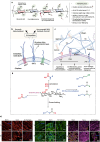Engineering extracellular matrix-based hydrogels for intervertebral disc regeneration
- PMID: 40375978
- PMCID: PMC12078266
- DOI: 10.3389/fbioe.2025.1601154
Engineering extracellular matrix-based hydrogels for intervertebral disc regeneration
Abstract
Lower back pain (LBP) is a major health concern, especially in older adults. A key aetiological factor is intervertebral disc (IVD) degeneration. It is mediated by dysregulation of extracellular matrix (ECM) and inflammation. In recent years, regenerative therapies have garnered attention for their potential to restore disc function by addressing the underlying biological alterations within the IVD. This review focuses on the comprehensive understanding of the anatomy and physiology of the IVD, highlighting its life cycle from embryonic development, and maturation to degenerative phenotype. We describe current treatments for managing LBP caused by IVD degeneration. This review emphasizes on the recent advancements in hydrogel engineering, highlighting natural, synthetic, and composite hydrogels and their application in ECM-targeted regenerative therapy for IVD degeneration. By exploring innovations in hydrogel technology, including improvements in crosslinking techniques and controlled degradation rates-we discuss how these materials could enhance IVD regeneration and potentially be used for the management of LBP. With their enhanced biomimicry, hydrogel-based ECM mimics offer a promising pathway for developing effective, durable therapies that address the root causes of disc degeneration, providing new hope for individuals living with chronic LBP.
Keywords: biomaterials; extracellular matrix; hydrogel; intervertebral disc degeneration; lower back pain.
Copyright © 2025 Kmail, Razak and Mohd Isa.
Conflict of interest statement
The authors declare that the research was conducted in the absence of any commercial or financial relationships that could be construed as a potential conflict of interest.
Figures







Similar articles
-
Self-Assembling Peptide Hydrogels as Functional Tools to Tackle Intervertebral Disc Degeneration.Gels. 2022 Mar 31;8(4):211. doi: 10.3390/gels8040211. Gels. 2022. PMID: 35448112 Free PMC article. Review.
-
Intervertebral disc and stem cells cocultured in biomimetic extracellular matrix stimulated by cyclic compression in perfusion bioreactor.Spine J. 2014 Sep 1;14(9):2127-40. doi: 10.1016/j.spinee.2013.11.062. Epub 2014 May 29. Spine J. 2014. PMID: 24882152
-
Research progress on intervertebral disc repair strategies and mechanisms based on hydrogel.J Biomater Appl. 2025 May;39(10):1121-1142. doi: 10.1177/08853282251320227. Epub 2025 Feb 10. J Biomater Appl. 2025. PMID: 39929142 Review.
-
Discogenic Low Back Pain: Anatomy, Pathophysiology and Treatments of Intervertebral Disc Degeneration.Int J Mol Sci. 2022 Dec 22;24(1):208. doi: 10.3390/ijms24010208. Int J Mol Sci. 2022. PMID: 36613651 Free PMC article. Review.
-
Extracellular matrix in intervertebral disc: basic and translational implications.Cell Tissue Res. 2022 Oct;390(1):1-22. doi: 10.1007/s00441-022-03662-5. Epub 2022 Jul 6. Cell Tissue Res. 2022. PMID: 35792910 Review.
Cited by
-
Tissue engineering strategies for treating intervertebral disc degeneration.Front Bioeng Biotechnol. 2025 Jul 14;13:1582189. doi: 10.3389/fbioe.2025.1582189. eCollection 2025. Front Bioeng Biotechnol. 2025. PMID: 40727644 Free PMC article. Review.
-
Regenerative strategies for intervertebral disc degeneration.J Orthop Translat. 2025 Jul 4;53:286-308. doi: 10.1016/j.jot.2025.06.003. eCollection 2025 Jul. J Orthop Translat. 2025. PMID: 40687553 Free PMC article. Review.
References
-
- Adoungotchodo A., Epure L. M., Mwale F., Lerouge S. (2021). Chitosan-based hydrogels supplemented with gelatine and Link N enhance extracellular matrix deposition by encapsulated cells in a degenerative intervertebral disc environment. Eur. Cell Mater 41, 471–484. 10.22203/ecm.v041a30 - DOI - PubMed
-
- Anjankar S. D., Poornima S., Raju S., Jaleel M., Bhiladvala D., Hasan Q. (2015). Degenerated intervertebral disc prolapse and its association of collagen I alpha 1 Spl gene polymorphism: a preliminary case control study of Indian population. Indian J. Orthop. 49 (6), 589–594. 10.4103/0019-5413.168765 - DOI - PMC - PubMed
Publication types
LinkOut - more resources
Full Text Sources
Miscellaneous

